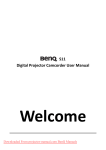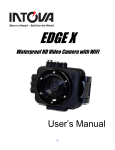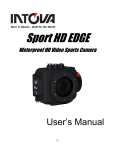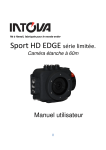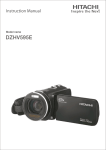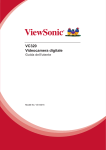Download Benq M11
Transcript
M11 Digital Camcorder User Manual Welcome <Note> Table of Contents 1 Overall Introduction ..........................12 1.1 1.2 1.3 1.4 1.5 2 System Requirements ................................ 12 Features ....................................................... 12 Accessories ................................................. 13 External View............................................... 14 Adjusting LCD Display................................ 15 Getting Started ..................................16 2.1 Inserting SD Card........................................ 16 2.2 Loading the Battery .................................... 17 2.3 Charging the Battery................................... 18 2.4 The Gestures of Using the Touch Screen . 19 2.4.1 Single touch......................................... 19 2.4.2 Slide..................................................... 20 2.4.3 Rotate .................................................. 20 2.5 Buttons & Functions................................... 21 2.6 About LED Indicators ................................. 22 2.7 Initial Settings Before Use.......................... 23 2.7.1 Setting Language ................................ 23 2.7.2 Setting Date and Time ......................... 24 3 LCD Display Information...................25 3.1 3.2 3.3 4 In DV Mode................................................... 25 In Voice Recording Mode ........................... 26 In DSC Mode ................................................ 27 Using the Camera..............................29 1 4.1 Shooting a Movie Clip................................. 29 4.2 Pause Recording a Movie Clip ................... 29 4.3 Shooting a photo......................................... 29 4.4 Voice Recording Mode................................ 29 4.5 Movie Clip / Voice Clip Playback................ 30 4.6 Shooting / Playback Photos ....................... 33 4.6.1 Shooting Photos .................................. 33 4.6.2 Playback Photos.................................. 33 5 LCD Display Information...................34 5.1 5.2 5.3 6 DV Playback Mode ...................................... 34 Voice Recording Playback Mode ............... 36 DSC Playback Mode.................................... 37 Menu Options ....................................38 6.1 Menus of Movie Clip Mode ......................... 38 6.1.1 Quality ................................................. 38 6.1.2 Resolution............................................ 39 6.1.3 Pre-recording....................................... 40 6.1.4 Time Lapse .......................................... 40 6.1.5 Dual Streams ....................................... 40 6.1.6 Face Detection .................................... 41 6.1.7 Scene Mode ........................................ 41 6.1.8 White Balance ..................................... 41 6.1.9 Effect ................................................... 42 6.1.10 Metering............................................... 43 6.1.11 EV Compensation................................ 43 6.1.12 Backlight .............................................. 44 2 6.1.13 Contrast ............................................... 44 6.1.14 Sharpness ........................................... 44 6.1.15 Motion Detection.................................. 45 6.2 Menu Options of Movie Clip/Voice Playback47 6.2.1 File Protection...................................... 47 6.2.2 Play Options ........................................ 48 6.2.3 Delete .................................................. 48 6.3 Menu Options of Camera Mode ................. 50 6.3.1 Quality ................................................. 50 6.3.2 Photo Size ........................................... 50 6.3.3 Capture Mode...................................... 51 6.3.4 Instant View ......................................... 52 6.3.5 Face Detection .................................... 52 6.3.6 Scene Mode ........................................ 52 6.3.7 White Balance ..................................... 53 6.3.8 Effect ................................................... 53 6.3.9 Metering............................................... 54 6.3.10 AE ISO................................................. 54 6.3.11 EV Compensation................................ 55 6.3.12 Backlight .............................................. 55 6.3.13 Contrast ............................................... 55 6.3.14 Sharpness ........................................... 56 6.4 Menu Options of Photo Playback .............. 57 6.4.1 File Protection...................................... 57 6.4.2 Slide Show Setting .............................. 57 6.4.3 Slide Show Effect................................. 58 6.4.4 Delete .................................................. 58 6.4.5 DPOF................................................... 59 6.4.6 Rotate .................................................. 59 3 6.5 Setting Menu................................................ 60 6.5.1 TV Type ............................................... 60 6.5.2 File Number (Default: Serial) ............... 61 6.5.3 Date/Time ............................................ 61 6.5.4 Format ................................................. 61 6.5.5 Default Setting ..................................... 61 6.5.6 LCD Brightness ................................... 62 6.5.7 Date/Time Stamp ................................. 62 6.5.8 Auto Power Off .................................... 62 6.5.9 Language............................................. 63 6.5.10 Flicker .................................................. 63 6.5.11 Information........................................... 64 6.5.12 Sound .................................................. 64 6.5.13 LCD Correction.................................... 64 6.5.14 Start Logo ............................................ 64 6.5.15 Digital Zoom ........................................ 65 7 PC and TV Connection......................66 7.1 7.2 Connecting to the Computer...................... 66 Connecting to TV ........................................ 66 8 Installing the Software ......................68 9 Editing Software ................................69 10 Appendix............................................70 Specifications ....................................................... 70 Troubleshooting ................................................... 72 4 Preface Congratulations on your purchase of this advanced camcorder (digital video camera). Ensure that you read this manual carefully and keep it in a safe place for future reference. About This Manual This manual is designed to assist you in using your new camcorder. All information presented is as accurate as possible but is subject to change without notice. Copyright Copyright 2010 by BenQ Corporation. All rights reserved. No part of this publication may be reproduced, transmitted, transcribed, stored in a retrieval system or translated into any language or computer language, in any form or by any means, electronic, mechanical, magnetic, optical, chemical, manual or otherwise, without the prior written permission of this company. Disclaimer BenQ Corporation makes no representations or warranties, either expressed or implied, with respect to the contents hereof and specifically disclaims any warranties, merchantability or fitness for any particular purpose. Further, BenQ Corporation reserves the right to revise this publication and to make changes from time to time in the contents hereof without obligation of this company to notify any person of such revision or changes. All other logos, products, or company names mentioned in this manual may be the registered trademarks or copyrights of their respective companies, and are used for informational purposes only. 5 Disposal of Waste Electrical and Electronic Equipment by users in private households in the European Union. This symbol on the product or on the packaging indicates that this can not be disposed of as household waste. You must dispose of your waste equipment by handing it over to the applicable take-back scheme for the recycling of electrical and electronic equipment. For more information about recycling of this equipment, please contact your city office, the shop where you purchased the equipment or your household waste disposal service. The recycling of materials will help to conserve natural resources and ensure that it is recycled in a manner that protects human health and environment. CE Regulatory Notice Hereby, BenQ Corp. declares under our responsibility that the product is in conformity with the requirements set out in the Council Directive on the Approximation of the Laws of the Member States relating, Electromagnetic Compatibility Directives (2004/108/EC) and Low Voltage Directive (2006/95/EC). A “Declaration of Conformity” in accordance with the above Directives has been made and is available from BenQ Corp. upon request. 6 FCC Statement This equipment has been tested and found to comply with the limits for a Class B digital device, pursuant to Part 15 of the FCC Rules. These limits are designed to provide reasonable protection against harmful interference in a residential installation. This equipment generates, uses and can radiate radio frequency energy and, if not installed and used in accordance with the instructions, may cause harmful interference to radio communications. However, there is no guarantee that interference will not occur in a particular installation. If this equipment does cause harmful interference to radio or television reception, which can be determined by turning the equipment off and on, the user is encouraged to try to correct the interference by one or more of the following measures: Reorient or relocate the receiving antenna. Increase the separation between the equipment and receiver. Connect the equipment into an outlet on a circuit different from that to which the receiver is connected. Consult the dealer or an experienced radio/TV technician for help. This device complies with Part 15 of the FCC Rules. Operation is subject to the following two conditions: (1) This device may not cause harmful interference, and (2) this device must accept any interference received, including interference that may cause undesired operation. FCC Caution: Any changes or modifications not expressly approved by the party responsible for compliance could void the user's authority to operate this equipment. 7 Safety Warning and Notice Before operating the camcorder, please make sure that you read and fully understand the content in this section. If you ignore and violate all safety warning notices indicated in this section, the camcorder warranty may be void. Meanwhile, not only the camcorder but also you and all other people and things around you may be severely damaged, injured, or even placed in danger of death. For your safety 1. Do not attempt to charge any other battery with this camcorder. 2. Operate the power supply only on even surfaces, without any cover. Air circulation around the product must be always given. The maximum ambient temperature is 40 ºC. 3. Risk of explosion if battery is replaced by an incorrect type. Dispose of used batteries according to the instructions. 4. Keep the camcorder and its accessories out of the reach of babies, toddlers, and children. In particular, small parts such as memory cards and batteries could be easily dismantled and swallowed by them. 5. Use only the original accessories to avoid possible risks to health and property, and thus meet all related legal regulations. 6. Do not dismantle the camcorder under any circumstances. 7. When using the flash, do not go too close to human eyes (particularly for babies, toddlers, and children) or animal eyes. Otherwise, when the flash fires, the light may cause damage to human eyes or irritate animals. 8 8. Batteries could explode, for instance. All batteries can cause property damage, injury or burns if a conductive material such as jewelry, keys or beaded chains touch exposed terminals. The material may complete an electrical circuit and become quite hot. Exercise care in handling any batteries, particularly when placing it inside your pocket, purse, or other container with metal objects. Do not dispose of batteries in fire as they may explode. 9. To prevent electric shock, do not attempt to disassemble or repair your camcorder by yourself. 10. Some camcorder models accept non-rechargeable batteries. When using these batteries, do not charge them. Otherwise, dangers such as explosion and fire may occur. Warranty 1. Warranty is void if damage or system failure occurred due to outside factors such as collision, fire, flood, dirt, sewage, earthquake, and other force majeure events as well as incorrect usage of electricity or use of non-original accessories. 2. It is the sole responsibility of the user if problems (such as data loss and system failure) occurred due to non-factory installed software, parts, and/or non-original accessories. 3. Do not change the camcorder. Any changes to the camcorder invalidate the warranty. Taking care of your camcorder 1. Always keep the camcorder in a leather case or pouch for better protection against splashes, dust, and collision. 2. The only way of replacing the battery and the memory card is to open the Battery / Memory cover. 3. Dispose of unwanted batteries and camcorders as permitted by the laws in your countries. 9 4. Water may cause a fire or electric shock. Therefore, store your camcorder in a dry place. 5. If your camcorder becomes wet, wipe it with a dry cloth as soon as possible. 6. Salt or seawater may cause severe camcorder damage. 7. Do not drop, knock, or shake the camcorder. A rude behavior of using the camcorder may damage the internal electronic circuit board or deform the lens shape. 8. Do not use harsh chemicals, cleaning solvents, or strong detergents to clean the camcorder. 9. Finger grease may be left on the camcorder lens and will result in unclear images or videos. To avoid this problem, be sure to clean the camcorder lens before taking pictures or recording videos. You should also clean the camcorder lens on a regular basis. 10. If the lens is dirty, use a lens brush or soft cloth to clean the lens. 11. Do not touch the lens with your fingers. 12. If a foreign substance or water gets in your camcorder, please turn the power off immediately and disconnect the batteries. Next, remove the foreign substance or water and send it to the maintenance center. 13. Whenever there is data in the external memory card, you should make a backup copy to a computer or disc. So, you can have a backup solution if data loss occurs. 14. All original accessories are designed only for use with this camcorder model you purchased. Do not use these accessories with other camcorder models or camcorders of other brands to avoid unpredictable danger or damage. 10 15. Before initial use of a memory card, always use the camcorder to format the card first. 16. Remember to slide the write-protect tab (if available) to the unlock position. Otherwise, all data (if any) on the memory card is protected and the card cannot be edited or formatted. Operating environment 1. Do not use or store your camcorder in the environments listed below: Direct sunlight Dusty places Next to an air conditioner, electric heater or other heat sources In a closed car that is in direct sunlight Unstable locations 2. Do not use your camcorder outdoors when it is raining or snowing. 3. Do not use your camcorder in or near water. 4. The camcorder operating temperature is between 0 and 40 degrees Celsius. It is normal for the operating time to be shortened when the temperature is low. 5. The capacity of your camcorder batteries will reduce each time it is charged/emptied. 6. Storage at too high or low temperatures will also result in a gradual capacity loss. As a result, the operating time of your camcorder may be considerably reduced. 7. It is normal for the camcorder to become warm during operation, because the camcorder casing can conduct heat. 11 1 Overall Introduction Please read this chapter to understand the features and functions of this Digital Video Camera. This chapter also includes the description of system requirement, package contents, and hardware components. 1.1 System Requirements This Digital Video Camera requires a unit of computer with the following specifications: • Windows® Vista / XP / Win 7 operating system or Mac OS 10.3 ~10.4 • A CPU of at least the equivalent of Intel® Pentium 4 2.8GHz I • At least 512 MB of RAM • Standard USB 1.1 connection port or higher • At least 64MB of display card Note: USB 1.1 allows you to transmit files to the host, but using USB 2.0 connection port could increase the transmission speed far faster. 1.2 Features This Digital Video Camera provides many features and functions including: • High resolution pixel camera (maximum 16 million pixels) • Touch screen • Time lapse • Pre-recording • Dual streams In addition, this video camera has USB mass storage hard disk, and SD card reader. 12 1.3 Accessories This package should contain the following items. In case there is any missing or damaged item, please contact your dealer immediately. ① Digital video camera ② Quick Guide ③ Software CD ④ HDMI cable ⑤ AV cable ⑥ USB cable ⑦ Lithium-Ion battery ⑧ Adaptor ⑨ Hand Strap Note: Available accessories depend on the actual items shipped and may vary from the list above. 13 1.4 External View Right View Front View Power Lens LED torch Self-timer Indicator USB/HDMI/AV Output Top View Bottom View Memory Card Compartment Zoom Shutter Button Button Tripod socket Speaker Rear View Left View Battery compartment Menu Button SET Button Hand Strap 14 LED Indicator Mode Button Recording Button Playback Button 1.5 Adjusting LCD Display Before taking pictures or recording movie clips, please rotate according to the illustrations below. 15 2 Getting Started 2.1 Inserting SD Card 1. Insert an SD card and make sure facing the touching face downward. Note: Do not remove or insert SD cards when the power of the Digital Video Camera is on to avoid damaging files. 16 2.2 Loading the Battery Please use only the battery provided or recommended by the manufacturer or dealer. Note: Insert the battery correctly according to this description. Error in inserting the battery could result in non-repairable damage to this Digital Video Camera. 1. Open battery cover. Battery Status Indicator: Battery full / Battery half full Battery empty 2. Insert the battery according to the illustration. 17 3. Close battery cover. 2.3 Charging the Battery You can use the adaptor attached to charge the Lithium-Ion battery. Insert the Lithium-Ion battery into the Digital Video Camera and connect to the cable of the adaptor. (You can also charge the battery by using the USB cable from a computer.) 18 2.4 The Gestures of Using the Touch Screen 2.4.1 Single touch You can touch hotkey to change settings as shown below (Take DV function as an example). LED torch: on AF lock: on Focus mode: (Auto Focus Menu / off / off / Touch AF ) 19 2.4.2 Slide Slide right or left to view the previous file or the next file under the [Playback] Mode. 2.4.3 Rotate Under [Playback] Mode, you can rotate the image by 90°/step as shown below. 20 2.5 Buttons & Functions Description Button Function Power Button To turn ON/OFF the Digital Video Camera. Menu Button To display the main OSD menu. MODE Button There are three operating modes for the Digital Video Camera: DV Mode, DSC Mode, and Voice Recording Mode. Press the Mode button to switch to different modes. SET Button To confirm all settings. 4-Way Direction Button In the DV or DSC mode, press this button Left/Right to adjust the EV compensation. Press this button Up in DSC mode to set up the flash light: off, auto, fill-in. Press Up in DV mode to turn on/off the LED torch. In the playback mode (thumbnail view), press Up/Down to toggle among video, image, and audio file views. When a file is selected, press Down to decide whether to delete this file. 21 Recording Button To take movie clips and voice recordings. Shutter Button To take images. Zoom Button This Digital Video Camera is equipped with 5X Optical Zoom: press the button Right (T) to pull in the distance of the subject, or press the button Left (W) to move away the distance from the object. Playback Button To enter Playback mode. 2.6 About LED Indicators Below table describes the meaning of the camera LED indicators: Indicator Color Definition Power Green Turning power on. Recording Red blinking Recording 22 2.7 Initial Settings Before Use 2.7.1 Setting Language 1. It is automatic to move on to Language setting after setting Date/Time. 2. Press the [4-Way Direction] Button left/right to select the language you want to use. 3. Press [SET] Button to confirm the setting. 23 2.7.2 Setting Date and Time 1. Turn [On] the Digital Video Camera to set up the date and time for the first time. Set the date and time by moving up/down button or touch the screen to select. 2. Press the [4-Way Direction] Button left/right to select each column. Then press left/down or touch the screen to select a value. 3. Press 24 . 3 LCD Display Information 3.1 In DV Mode Please refer to the following table. 1 Resolution indicator 2 Scene mode Indicator 3 Remaining recording time indicator 4 DV mode indicator 5 Battery status indicator 6 White balance indicator 7 Exposure compensation indicator 8 Metering mode 9 Playback button 10 Histogram indicator 11 Menu button 25 12 Focus mode button 13 Auto Focus button 14 LED torch button (On/Off) 3.2 In Voice Recording Mode Please refer to the following table. 1 Recording time left indicator 2 Voice Recording Mode indicator 3 Battery status indicator 4 Playback button 5 Menu button 26 3.3 In DSC Mode Please refer to the following table. 1 Resolution indicator 2 Scene Mode indicator 3 Number of pictures left 4 DSC Mode indicator 5 Battery indicator 6 White balance indicator 7 EV compensation indicator 8 Metering mode 9 Playback button 10 Histogram indicator 11 Menu button 27 12 Flashlight mode selection (off/auto/fill-in) 13 Focus mode button 14 Self-timer indicator 15 Face Detection 16 Drive mode 28 4 Using the Camera 4.1 Shooting a Movie Clip 1. [DV] mode is the default setting after you power [On] the Digital Video Camera. 2. Press the [Recording] Button to start/stop recording. 3. The Digital Video Camera will store the movie clip automatically. 4.2 Pause Recording a Movie Clip 1. Press [SET] Button during recording a movie clip. The video will pause recording immediately. 2. Press [SET] Button again to start recording a movie clip. 3. The Digital Video Camera will store the video automatically. 4.3 Shooting a photo 1. Turn [On] the Digital Video Camera, press [Mode] Button to switch to [DSC] mode. 2. Press [Shutter] Button to take pictures. 3. The Digital Video Camera will store the image automatically. 4.4 Voice Recording Mode 1. Turn [On] the Digital Video Camera, press [Mode] Button to switch to [Voice Recording] mode. 2. Press [Recording] Button to start/stop voice recording. 29 4.5 Movie Clip / Voice Clip Playback 1. In [DV]/ [DSC]/ [Voice Recording] Recording Mode, press [Playback] Button to display recently stored files on the LCD screen. Playback Movie clip playback mode Voice clip playback mode 2. Press [4-Way Direction] Button up/down, left/right to view stored files. Press [SET] Button to playback or touch the screen to select Playback of the file. 30 3. To pause the Playback of file, press the [Recording] Button or touch the screen icon . 4. Press [Playback] Button again to return to DV/DSC/Voice Recording Mode. Press [Playback] Button again to return to DV/DSC/Voice Recording Mode. 5. You can also playback the movie clip in different speeds by touching (ON/OFF) the screen icon . 31 Playback speed is as below when the Slow Motion is “OFF”: Rewind (1/2X, 1/4X, 1/8X, 1/16X, 1/32X, or 1/64X) Playback (Normal 1X) Forward (2X, 4X, 8X, 16X, 32X, or 64X) 6. Capture the image from movie clip playback. Press [Shutter] Button in replaying the movie clip. The Digital Video Camera will store images automatically. Resolution 1920 x 1080 or 1280 x 720 or 848 x 480 432 x 240 Note: The image size depends on Resolution. 32 4.6 Shooting / Playback Photos 4.6.1 Shooting Photos 1. Turn [On] the power and adjust the [Mode] Button to [DSC] Mode. 2. Press [Shutter] Button to capture images which will be stored automatically. 4.6.2 Playback Photos 1. In [DSC] Mode, press [Playback] Button to display the images on the LCD screen. 2. Press [4-Way Direction] Button up/down or left/right to view the stored files. Press [SET] Button or touch the screen to playback the image. 3. Touch the screen ( or ) to enlarge/shrink the image, then you can move the image up/down or left/right. 4. Press [Playback] Button again to return to [DSC] Mode. 33 5 LCD Display Information 5.1 DV Playback Mode Please refer to the following table. 1 Folder and file number 2 Length of each Movie Clip 3 File Protection indicator 4 Battery status indicator 5 Resolution indicator 6 Slow motion playback button 7 Return button 8 Sound volume touch icons 9 Volume (“+” for up and “-“ for down) 10 Playback/Pause button 11 Fast forward playback button 34 12 Fast rewind playback button 13 Menu button 14 Delete button 35 5.2 Voice Recording Playback Mode Please refer to the following table. 36 1 Folder and file number 2 Length of each voice clip 3 File Protection indicator 4 Battery status indicator 5 Return button 6 Sound volume touch icons 7 Volume (“+” for up and “-“ for down) 8 Playback/Pause button 9 Fast forward playback button 10 Fast rewind playback button 11 Menu button 12 Delete button 5.3 DSC Playback Mode Please refer to the following table. 1 Folder and file number 2 DPOF(Digital Print Order Format) indicator 3 File Protection indicator 4 Battery status indicator 5 ISO value 6 Resolution indicator 7 Return button 8 Zoom-Out indicator 9 Zoom-In indicator 10 Next file 11 Previous file 12 Menu button 13 Delete button 37 6 Menu Options Please read this chapter to understand the settings and advanced operations of this Digital Video Camera. 6.1 Menus of Movie Clip Mode Press [MENU] button to display menu options of movie clip under the [DV] mode. 6.1.1 Quality 1. Turn [On] the Digital Video Camera and ensure it is in the [DV] mode. 2. Press [MENU] Button and press [4-way Direction] Button to select the [Quality] item. Press [SET] Button to display submenu; or touch the screen to select the item. 3. Press [4-way Direction] Button to select [Super Fine], [Fine], or [Normal]. Press [SET] Button or touch the screen to confirm the setting. 38 6.1.2 Resolution 1. Power [On] the Digital Video Camera and make sure it is in the [DV] mode. 2. Press [MENU] Button and press [4-way Direction] Button to select the [Resolution] item. Press [SET] Button or touch the screen to display submenu. 3. Use [4-way Direction] Button to select and press [SET] Button to confirm; or touch the screen to select the item. 1920 x 1080 30fps 16:9 1280 x 720 60fps 16:9 1280 x 720 30fps 16:9 848 x 480 60fps 16:9 848 x 480 30fps 16:9 432 x 240 240fps 16:9 Note: The resolution will be different due to various TV Type settings. Please refer to chapter 6.5.1 “TV Type”. 39 6.1.3 Pre-recording 1. Power [On] the Digital Video Camera and make sure it is in the [DV] mode. 2. Press [MENU] Button and press [4-way Direction] Button to select the [Pre-recording] item. Press [SET] Button or touch the screen to display submenu. 3. Use [4-way Direction] Button to choose [Off]/[On], and press [SET] Button or click the screen to confirm the setting. 6.1.4 Time Lapse 1. Power [On] the Digital Video Camera and ensure it is in the [DV] mode. 2. Press [MENU] Button and press [4-way Direction] Button to choose the [Time Lapse] item. Press [SET] Button or touch the screen to display submenu. 3. Use [4-way Direction] Button to select [Off], [1 minute], [5 minutes], or [30 minutes]. Press [SET] Button or touch the screen to confirm. 6.1.5 Dual Streams 1. Power [On] the Digital Video Camera and make sure it is in the [DV] mode. 2. Press [MENU] Button and press [4-way Direction] Button to select the [Dual streams] item. Press [SET] Button or touch the screen to display submenu. 3. Press [4-way Direction] Button to select [Off]/ [On]. Press [SET] Button or touch the screen to confirm the setting. Note: Dual streams only support these video formats: 1920 x 1080 30fps, 1280 x 720 60fps, and 1280 x 720 30fps. 40 6.1.6 Face Detection 1. Power [On] the Digital Video Camera and ensure it is in the [DV] mode. 2. Press [MENU] Button and press [4-way Direction] Button to select the [Face Detection] item. Press [SET] Button or touch the screen to display submenu. 3. Press [4-way Direction] Button to select [Off]/ [On]. Press [SET] Button or click the screen to confirm. 6.1.7 Scene Mode 1. Power [On] the Digital Video Camera and make sure it is in the [DV] mode. 2. Press [MENU] Button and press [4-way Direction] Button to select the [Scene Mode] item. Press [SET] Button to display submenu; or touch the screen to choose the item. 3. Press [4-way Direction] Button to select [Auto] , [Night] , [Sports] , [Landscape] , [Portrait] , [Sunset] , [Sand, Snow] , [Flower] , [Firework] , or [Aquarium] . Press [SET] Button or touch the screen to confirm. 6.1.8 White Balance 1. Power [On] the Digital Video Camera and ensure it is in the [DV] mode. 2. Press [MENU] Button and press [4-way Direction] Button to select the [White Balance] item. Press [SET] Button to display submenu; or touch the panel to select the item. 3. Press [4-way Direction] Button to select [Auto], [Incandescent], [Daylight], [Cloudy], [Fluorescent], or [Preset]. Press [SET] Button or touch the panel to confirm. 41 Auto Automatic white balance adjustment. Incandescent The setting is suitable for Incandescent lamp lighting, or environments with dark light. Daylight For daylight recording. Cloudy For cloudy or shady environments. Fluorescent For fluorescent lamp lighting, or environments with bright light. Preset Preset on a plain white background for more realistic white balance value. 6.1.9 Effect 1. Power [On] the Digital Video Camera and make sure it is in the [DV] mode. 2. Press [MENU] Button and press [4-way Direction] Button to select the [Effect] item. Press [SET] Button to display submenu; or touch the screen to select the item. 3. Press [4-way Direction] Button to select [Normal], [Art], [Sepia], [Negative], [B/W (Black/White)], or [Vivid]. Press [SET] Button to confirm; or touch the screen to select the item. 42 Normal Recordings with natural color. Art Recordings with oil painting color. Sepia Recordings with sepia-toned color. Negative Recordings with negative color. B/W Recordings with black/white color. Vivid Recordings with bright color. 6.1.10 Metering 1. Power [On] the Digital Video Camera and make sure it is in the [DV] mode. 2. Press [MENU] Button and press [4-way Direction] Button to select the [Metering] item. Press [SET] Button or touch the screen to display submenu. 3. Press [4-way Direction] Button to select [Center], [Average], or [Spot]. Press [SET] Button or touch the screen to confirm. Center To preserve background details while letting lighting conditions at the center of the frame define exposure. Averaged For exposure to be evenly distributed around the selected frame. Spot To ensure correct exposure for the object even if the background is very bright or very dark. 6.1.11 EV Compensation Use this function to adjust the value of EV compensation, which is ranged from -2.0EV to +2.0EV (at 0.3EV increment). The higher the EV value, the brighter the image will be. 1. Power [On] the Digital Video Camera and ensure it is in the [DV] mode. 2. Press [MENU] Button and then press [4-way Direction] Button to select the [EV Compensation] item. Press [SET] Button or touch the screen to display submenu. 3. Press [4-way Direction] Button to increase/decrease the value. Press [SET] Button or touch the screen to confirm. 43 6.1.12 Backlight 1. Turn [On] the Digital Video Camera and make sure it is in the [DV] mode. 2. Press [MENU] Button and press [4-way Direction] Button to select the [Backlight] item. Press [SET] Button or touch the screen to display submenu. 3. Press [4-way Direction] Button to select [Off]/ [On]. Press [SET] Button or touch the screen to confirm. 6.1.13 Contrast 1. Turn [On] the Digital Video Camera and ensure it is in the [DV] mode. 2. Press [MENU] Button and press [4-way Direction] Button to select the [Contrast] item. Press [SET] Button or touch the screen to display submenu. 3. Press the [4-way Direction] Button to select [Normal], [High], or [Low]. Press [MENU] Button or touch the screen to confirm. Normal For normal scenes. High For brighter scenes. Low For darker scenes. 6.1.14 Sharpness 1. Power [On] the Digital Video Camera and ensure it is in the [DV] mode. 2. Press [MENU] Button and press [4-way Direction] Button to select the [Sharpness] item. Press [SET] Button or touch the screen to display submenu. 3. Press [4-way Direction] Button to select [Normal], [High], or [Low]. Press [SET] Button or touch the screen to confirm. 44 Normal For normal scenes. High For sharper scenes. Low For softer scenes. 6.1.15 Motion Detection 1. Power [On] the Digital Video Camera and make sure it is in the [DV] mode. 2. Press [MENU] Button and press [4-way Direction] Button to select the [Motion Detection] item. Press [SET] Button or touch the screen to display submenu. 3. Press [4-way Direction] Button to select [On] or [Off]. Press [SET] Button or touch the screen to confirm. The following image will be shown when the motion detection function is on: Motion Detection On 45 If the pillar rises to peak, the Digital Video Camera will take movie clips automatically without pressing the recording button. Start recording If the pillar disappears, the Digital Video Camera will end taking movie clips automatically without pressing the recording button. End recording 46 6.2 Menu Options of Movie Clip/Voice Playback When in [Movie Clip]/ [Voice] playback mode, press the [MENU] Button to show the movie clip options menu. 6.2.1 File Protection 1. Power [On] the Digital Video Camera and make sure it is in the [Movie Clip]/ [Voice] Playback mode. 2. Press [MENU] Button. Then, press [4-way Direction] Button or touch the screen to select the [File Protection] item. Press [SET] Button or touch the screen to display submenu. 3. The icon represents the file is under protection. Protect One Protect one file. Unprotect One Unprotect one file. Protect All Protect all files. Unprotect All Unprotect all files. :To unlock the file from Protect, repeat steps stated above. After the file is Note: unlocked from Protect mode, the locked icon will disappear. 47 6.2.2 Play Options 1. Power [On] the Digital Video Camera and make sure it is in the [Movie Clip]/ [Voice] playback mode. 2. Press [MENU] Button. Then, press [4-way Direction] Button or touch the screen to select the [Play Options] item. Press [SET] Button or touch the screen to display submenu. 3. Use [4-way Direction] Button to select [Play One], [Play All], [Repeat One], or [Repeat All], then press [SET] Button or touch the screen to confirm. The movie clip will playback automatically. Play One To playback one file. Play All To playback all files. Repeat One To replay single file. Repeat All To replay all files. 6.2.3 Delete 1. Power [On] the Digital Video Camera and make sure it is in the [Movie Clip]/ [Voice] playback mode. 2. Choose the to-be-deleted file and press [MENU] Button/ press [4-way Direction] Button down to select the [Delete] item; or touch the screen to select the item. 3. Use [4-way Direction] Button to select [Delete One], [Delete All], or [Delete Selections]; then press [SET] Button or touch the screen to confirm. 4. Press [4-way Direction] Button or touch the screen to select [V]/ [X] and press [SET] Button to delete file(s). 5. You can choose the [Delete Selections] item to delete certain file. 48 Delete One Delete one file. Delete All Delete all files. Delete Selections Select the file and delete. Note: The files cannot be recovered once deleted. Therefore, please make sure you have a backup file before delete. The protect files will not be able to delete. You must unlock the file before deleting it. 49 6.3 Menu Options of Camera Mode During [DSC] Mode, press [MENU] Button to display camera mode option menu. 6.3.1 Quality 1. Turn [On] the Digital Video Camera and ensure it is in the [DSC] mode. 2. Press [MENU] Button and press [4-way Direction] Button to select the [Quality] item. Press [SET] Button or touch the screen to display submenu. 3. Press [4-way Direction] Button to select [Super Fine], [Fine], or [Normal]. Press [SET] Button or touch the screen to confirm the setting. 6.3.2 Photo Size 1. Power [On] the Digital Video Camera and make sure it is in the [DSC] mode. 2. Press [MENU] Button and press [4-way Direction] Button to select the [Photo Size] item. Press [SET] Button or touch the screen to display submenu. 3. Press [4-way Direction] Button to select [16M], [10M], [3:2], [16:9], or [2M]. Press [SET] Button or touch the screen to confirm. 50 16M 4608 x 3456 pixels (Interpolation) 10M 3648 x 2736 pixels 3:2 3648 x 2432 pixels 16:9 3648 x 2048 pixels 2M 1824 x 1360 pixels 6.3.3 Capture Mode 1. Power [On] the Digital Video Camera and make sure it is in the [DSC] mode. 2. Press [MENU] Button and then press [4-way Direction] Button to select the [Capture Mode] item. Press [SET] Button or touch the screen to display submenu. 3. Press [4-way Direction] Button to select [Normal], [Continue Shot], [AEB mode], [Fast Cont.], or [Super Fast Cont.]. Press [SET] Button or touch the screen to confirm. Normal Shoot single photo. Continue Shot Shoot photos continually. AEB mode Shoot three photos continually.(For brighter, normal, darker photo each) Fast Cont. Shoot 10 photos continually. Super Fast Cont. Shoot 30 photos continually. 51 6.3.4 Instant View 1. Turn [On] the Digital Video Camera and ensure it is in the [DSC] mode. 2. Press [MENU] Button and press [4-way Direction] Button to select the [Instant View] item. Press [SET] Button to display submenu or touch the screen to select the item. 3. Press [4-way Direction] Button to select [Off], [1 second], [3 seconds], or [5 seconds]. Press [SET] Button or touch the screen to confirm. 6.3.5 Face Detection 1. Power [On] the Digital Video Camera and make sure it is in the [DSC] mode. 2. Press [MENU] Button and press [4-way Direction] Button to select the [Face Detection] item. Press [SET] Button or touch the screen to display submenu. 3. Press [4-way Direction] Button to select [Off], or [On]. Press [SET] Button or touch the screen to confirm. 6.3.6 Scene Mode 1. Turn [On] the Digital Video Camera and make sure it is in the [DSC] mode. 2. Press [MENU] Button and press [4-way Direction] Button to select the [Scene Mode] item. Press [SET] Button or touch the screen to display submenu. 3. Press [4-way Direction] Button to select [Auto] , [Night] , [Sports] , [Landscape] , [Portrait] , [Sunset] , [Sand, Snow] , [Flower] , [Firework] , or [Aquarium] . Press [SET] Button or touch the screen to confirm. 52 6.3.7 White Balance 1. Power [On] the Digital Video Camera and make sure it is in the [DSC] mode. 2. Press [MENU] Button and press [4-way Direction] Button to select the [White Balance] item. Press [SET] Button or touch the screen to display submenu. 3. Press [4-way Direction] Button to select [Auto], [Incandescent], [Daylight], [Cloudy], [Fluorescent], or [Preset]. Press [SET] Button or touch the screen to confirm. Auto Automatic white balance adjustment. Incandescent The setting is suitable for Incandescent lamp lighting, or environments with dark light. Daylight For daylight recording. Cloudy For cloudy or shady environments. Fluorescent For fluorescent lamp lighting, or environments with bright light. Preset Preset on a plain white background for more realistic white balance value. 6.3.8 Effect 1. Turn [On] the Digital Video Camera and ensure it is in the [DSC] mode. 2. Press [MENU] Button and press [4-way Direction] Button to select the [Effect] item. Press [SET] Button or click the screen to display submenu. 3. Press [4-way Direction] Button to select [Normal], [Art], [Sepia], [Negative], [B/W (Black/White)], or [Vivid]. Press [SET] Button to confirm; or touch the screen to select the item. 53 Normal Images with nature color. Art Images with oil painting color. Sepia Images with sepia-toned color. Negative Images with negative color. B/W Images with black/white color. Vivid Images with bright color. 6.3.9 Metering 1. Turn [On] the Digital Video Camera and make sure it is in the [DSC] mode. 2. Press [MENU] Button and press [4-way Direction] Button to select the [Metering] item. Press [SET] Button or touch the screen to display submenu. 3. Use [4-way Direction] Button to select [Center], [Average], or [Spot]. Press [SET] Button or touch the screen to confirm the setting. Center Averaged Spot To preserve background details while letting lighting conditions at the center of the frame define exposure. For exposure to be evenly distributed around the selected frame. To ensure correct exposure for the object even if the background is very bright or very dark. 6.3.10 AE ISO 1. Power [On] the Digital Video Camera and make sure it is in the [DSC] mode. 2. Press [MENU] Button and press [4-way Direction] Button to select the [AE ISO] item. Press [SET] Button or touch the panel to display submenu. 54 3. Press [4-way Direction] Button to select [Auto], [100], [200], [400], [800], [1600], [3200], or [6400]. Press [SET] Button or touch the panel to confirm. 6.3.11 EV Compensation Use this function to adjust the value of EV compensation, which is ranged from -2.0EV to +2.0EV (at 0.3EV increment). The higher the EV value, the brighter the image will be. 1. Power [On] the Digital Video Camera and make sure it is in the [DSC] mode. 2. Press [MENU] Button and press [4-way Direction] Button to select the [EV Compensation] item. Press [SET] Button or touch the screen to display submenu. 3. Press [4-way Direction] Button to increase/decrease the value. Press [SET] Button or touch the screen to confirm. 6.3.12 Backlight 1. Power [On] the Digital Video Camera and ensure it is in the [DSC] mode. 2. Press [MENU] Button and press [4-way Direction] Button to select the [Backlight] item. Press [SET] Button or touch the screen to display submenu. 3. Press [4-way Direction] Button to select [Off] or [On]. Press [SET] Button or touch the screen to confirm. 6.3.13 Contrast 1. Turn [On] the Digital Video Camera and ensure it is in the [DSC] mode. 2. Press [MENU] Button and press [4-way Direction] Button to select the [Contrast] item. Press [SET] Button or touch the screen to display submenu. 3. Press [4-way Direction] Button to select [Normal], [High], or [Low]. Press [SET] Button or touch the screen to confirm. 55 Normal Images with normal scenes. High Images with brighter scenes. Low Images with darker scenes. 6.3.14 Sharpness 1. Power [On] the Digital Video Camera and make sure it is in the [DSC] mode. 2. Press [MENU] Button and press [4-way Direction] Button to select the [Sharpness] item. Press [SET] Button or touch the screen to display submenu. 3. Press [4-way Direction] Button to select [Normal], [High], or [Low]. Press [SET] Button or touch the screen to confirm. 56 Normal Images with normal scenes. High Images with sharper scenes. Low Images with softer scenes. 6.4 Menu Options of Photo Playback 6.4.1 File Protection 1. Turn [On] the Digital Video Camera and ensure it is in the [Playback] mode. 2. Press [MENU] Button and press [4-way Direction] Button to select the [File Protection] item; press [SET] Button or touch the screen to display submenu. 3. The locked icon protection. will be shown to indicate the file is under Protect One Protect one file. Unprotect One Unprotect one file. Protect All Protect all files. Unprotect All Unprotect all files. Note: Repeat above-mentioned steps to unlock the file. locked icon will disappear. 6.4.2 When the file is unlocked, the Slide Show Setting 1. Turn [On] the Digital Video Camera and make sure it is in the [DSC] mode. 2. Press [4-way Direction] Button to select the [Slide Show Setting] item to enter into submenu; or touch the screen to select the item. 57 3. Use [4-way Direction] Button or touch the screen to choose [Off], [1 Second], or [3 Seconds]. The images will playback automatically. 6.4.3 Slide Show Effect 1. Turn [On] the Digital Video Camera and make sure it is in the [Playback] mode. 2. Press [MENU] Button and press [4-way Direction] Button to select the [Slide Show Effect] item; press [SET] Button or touch the screen to display submenu. 3. Use [4-way Direction] Button to select [Fading] or [Flying], press [SET] Button or touch the screen to display submenu. 6.4.4 Delete 1. Turn [On] the Digital Video Camera and make sure it is in the [Playback] mode. 2. Choose the to-be-deleted file and press the [MENU] Button/ [4-way Direction] Button down to select the [Delete] item; press [SET] Button to display submenu. 3. Use [4-way Direction] Button to select [Delete One], [Delete All], or [Delete Selections]. Press [SET] Button or touch the screen to confirm. 4. Press [4-way Direction] Button/touch the screen to choose [V] or [X] and press [SET] Button to delete file(s). You can choose [Delete Selections] to delete certain file. Delete One 58 Delete one file. Delete All Delete all files. Delete Selections Choose the file and delete. Note: The files cannot be recovered once deleted. Therefore, please make sure you have a backup file before delete. The protect files will not be able to delete. You must unlock the file before deleting the protected file. 6.4.5 DPOF Use DPOF (Digital Print Order Format) to mark the printing information stored in the memory card. 1. Turn [On] the Digital Video Camera and make sure it is in the [Playback] mode. Press [Playback] Button and then press [MENU] Button to show menu options of image playback; or touch the panel to select the item. 2. Press [4-way Direction] Button to select the [DPOF] item, and press [SET] Button or touch the screen to confirm. 3. Use [4-way Direction] Button and press [SET] Button to confirm; or touch the screen to choose the item. The DPOF icon will appear to indicate the file is in order for printing. Notes: 1. A memory card is necessary for using DPOF function. 2. All videos/pictures are in order for printing after setting DPOF. 6.4.6 Rotate 1. Turn [On] the Digital Video Camera and make sure it is in the [Playback] mode. Then press [4-way Direction] Button to select your target image by pressing [SET] Button. 2. Touch the screen to select [MENU] or press [MENU] button, then press [4-way Direction] Button to select the [Rotate] item to enter into submenu; or touch the screen to choose the item. 3. Use [4-Way Direction] Button to select [Left 90] or [Right 90] and press [SET] Button to confirm; or touch the screen to select the item. The image will rotate left/right by 90 degrees. 59 6.5 Setting Menu Setting Menu can be applied on all kinds of the Digital Video Camera settings. 6.5.1 TV Type 1. Power [On] the Digital Video Camera and switch to [Setting] mode. 2. Press [4-way Direction] Button to select the [TV Type] item. Press [SET] Button or touch the panel to display submenu. 3. Use [4-way Direction] Button to choose [NTSC] or [PAL], then press [SET] Button or touch the screen to confirm. Note: The video resolution will be different due to various TV Type settings. Setting reference of TV type based on the following country/region 60 NTSC America, Canada, Japan, Korea, Mexico, Taiwan PAL Australia, Austria, Belgium, China, Denmark, Finland, Germany, UK, Italy, Kuwait, Malaysia, New Zealand, Singapore, Spain, Sweden, Switzerland, Thailand, Norway 6.5.2 File Number (Default: Serial) The file number can be set in this function. 1. Turn [On] the Digital Video Camera and switch to [Setting] mode. 2. Press [4-way Direction] Button to select the [File Number] item. Press [SET] Button or touch the screen to display submenu. 3. Press [4-way Direction] Button to choose [Reset]/ [Serial], then press [SET] Button or touch the panel to confirm. Notes: 1. The file number will start from 0001 when setting to [Reset]. 2. When setting to [Serial], the stored files will be in serial numbers. 6.5.3 Date/Time Please refer to the chapter 2.7.1 “Setting Date/Time.” 6.5.4 Format Use this function to format the memory card/ built-in memory. 1. Turn [On] the Digital Video Camera and switch to [Setting] mode. 2. Use [4-way Direction] Button to select the [Format] item. Press [SET] Button or touch the screen to display submenu. 3. Press [4-way Direction] Button to select [V] or [X] to confirm; or touch the screen to click the item. 6.5.5 Default Setting Use this function to reset from all settings to default settings. 1. Power [On] the Digital Video Camera and switch to [Setting] mode. 2. Press [4-way Direction] Button to select the [Default Setting] item, then press [SET] Button or touch the screen to display submenu. 61 3. Press [4-way Direction] Button/ touch the screen to choose [V] or [X], press [SET] Button or touch the screen to confirm. 6.5.6 LCD Brightness This function is to adjust the brightness of LCD. 1. Turn [On] the Digital Video Camera and switch to [Setting] mode. 2. Use [4-way Direction] Button to select the [LCD Brightness] item, then press [SET] Button or click the screen to confirm. 3. Use [4-way Direction] Button to select [Low], [Medium], or [High], then press [SET] Button or touch the screen to confirm the setting. 6.5.7 Date/Time Stamp This function is to stamp date/time on photos. 1. Turn [On] the Digital Video Camera and switch to [Setting] mode. 2. Press [4-way Direction] Button to select the [Date/Time Stamp] item, press [SET] Button to display submenu; or touch the screen to select the item. 3. Use [4-way Direction] Button to choose [Off], [Date], or [Date/Time], press [SET] Button or touch the screen to confirm the setting. 6.5.8 Auto Power Off This function is to power off the Digital Video Camera to save energy after it is not in use for several minutes. 1. Power [On] the Digital Video Camera and switch to [Setting] mode. 2. Press [4-way Direction] Button to select the [Auto Power Off] item, then press [SET] Button or touch the screen to display submenu. 62 3. Use [4-way Direction] Button to choose [Off], [3 min], or [5 min]. Press [SET] Button or touch the screen to confirm the setting. 6.5.9 Language Please refer to chapter 2.7.2 “Setting Time/Date and Language.” 1. Turn [On] the Digital Video Camera and switch to [Setting] mode. Move [4-way Direction] Button left/right to select the [Language] item, and press [SET] Button or click the screen to confirm. 2. Press [4-way Direction] Button/touch the screen to select the following languages: English, Deutsch, French, Spanish, Italian, Japanese, Portuguese, Traditional Chinese, Simplified Chinese, Turkish, Russian, Thai, Arabian, and Korean. 6.5.10 Flicker Use this setting to adjust the frequency system which corresponds to your local area. 1. Turn [On] the Digital Video Camera and switch to [Setting] mode. 2. Press [4-way Direction] Button to select the [Flicker] item, press [SET] Button or touch the screen to display submenu. 3. Press [4-way Direction] Button/touch the screen to select [Auto], [60Hz], or [50Hz]. Press [SET] Button or touch the screen to confirm. Reference of frequency setting 50HZ UK, Germany, Spain, Italy, France, Netherlands, Portugal, Russia, China, Japan 60HZ USA, Taiwan, Korea, Japan 63 6.5.11 Information This function is to show information on the LCD screen to help you taking better photos/movie clips. 1. Power [On] the Digital Video Camera and switch to [Setting] mode. 2. Press [4-way Direction] Button to select the [Information] item, and press [SET] Button or touch the screen to display submenu. 3. Use [4-way Direction] Button to select [Normal], [Histogram], or [Off]. Press [SET] Button or touch the screen to confirm. 6.5.12 Sound Use this function to adjust the sound volume. 1. Turn [On] the Digital Video Camera and switch to [Setting] mode. 2. Press [4-way Direction] Button to select the [Sound] item. Press [SET] Button or touch the screen to display submenu. 3. Press [4-way Direction] Button to select [High], [Medium], [Low], or [Off], then press [SET] Button or touch the screen to confirm. 6.5.13 LCD Correction This function is to correct the accuracy of LCD touch screen. 6.5.14 Start Logo Use this function to set up the image shown on the screen when the Digital Video Camera is turned on. 1. Power [On] the Digital Video Camera and switch to [Setting] mode. 2. Press [4-way Direction] Button and choose the [Start Logo] item, press [SET] Button or touch the screen to display submenu. 64 3. Press [4-way Direction] Button to select [Default Setting] or [User Setting]. Press [SET] Button/touch the panel to choose the item. 6.5.15 Digital Zoom 1. Power [On] the Digital Video Camera and make sure it is in the [DV] mode. 2. Press [MENU] Button and press [4-way Direction] Button to select the [Digital Zoom] item. Press [SET] Button or touch the screen to display submenu. 3. Press [4-way Direction] Button to select [Off], [X10], or [Maximum]. Press [SET] Button or touch the screen to confirm. 65 7 PC and TV Connection 7.1 Connecting to the Computer As shown below, use the provided USB cable and connect the Digital Video Camera to a PC for file transmission. 7.2 Connecting to TV As shown below, use the provided video cable and connect the Digital Video Camera to a TV. 66 As shown below, use the provided HDMI cable to connect the Digital Video Camera to a TV for high resolution picture display. 67 8 Installing the Software 1. Place the attached CD ROM into the CD player. 2. If the CD does not execute automatically, please use Windows File Manager to execute the Install_CD.exe file in the CD. The following screen will be shown up. 3. 68 Press the [Menu] item to start the installation process according to the instructions on-screen. 9 Editing Software ArcSoft Total Media Extreme (TME) ™ manages your media for you, and gives you tons of fun and exciting ways to create and share projects featuring your photo, video, and music files. Edit, enhance and add creative effects to your photos. You can Create your own movies or photo slide shows complete with soundtrack. Upload your files easily to YouTube™! Or share them through simple email attachments or popular photo printing. You can go to http://www.arcsoft.com/ for more information. 69 10 Appendix Specifications Sensor Aptina 10 Mega Pixels, 1/2.3 inch CMOS Zoom 5X optical zoom Digital zoom: Still: 60X ,Video: 100X Playback: Up to 10X Lens F = 3.2 (W) ~ 6.3 (T) f = 6.26 ~ 30.75 mm Focus range Movie Record: 10 cm ~ Infinity Capture Mode: 10 cm ~ Infinity (Wide); 80cm ~ Infinity (Tele) Macro: 10 cm (Wide) LCD 3.0" LCD 230k pixels Movie Mode Full HD 1920x1080; HD 1280x720; WVGA 848x480; Web 432x240 Image Resolution 16M (4608 x 3456 interpolated) 10M (3648 x 2736) 3:2 (3648 x 2432) 16:9 (3648 x 2048) 2M (1824 x 1360) Shutter Speed Auto: 1/8000 ~ 1/2 sec. Night: 1/8000 ~ 2 sec. Power Source 1050 mAh NP60 rechargeable Lithium-Ion battery Storage Type SD/SDHC compatible (up to 32 GB) 70 File Format Still Image: JPEG (EXIF 2.2 compatible) Video: MOV Dimensions / Weight 112 x 50.3 x 59.5 mm 240 g (without battery & SD card) Interface Digital output: USB 2.0 compatible Audio / Video output: NTSC/PAL; HDMI Accessories Quick Guide / Lithium-Ion battery / AV Cable / HDMI cable / USB cable / Software CD ROM / Adaptor / Hand Strap 71 Troubleshooting Problem Possible Cause Solution Can not turn on the power of Digital Video Camera. 1. The Battery is not inserted correctly. 2. The Battery is dead. 1. Please insert the battery correctly. 2. Replace the battery. Pictures are not stored in the memory. Power off before storing the images. Please change to a new battery when the battery indicator turns to red color. Camera shutdown when using Self-timer shooting picture. The Battery in camera is dead. Change to a new battery. Images are out of focus Object exceeds the range of focus. Refocus by zooming in/out. Unable to use the external memory card. 1. Memory card is protected. 2. Memory card contains non-DCF images taken by other cameras. All buttons can not work or camera hangs. Short circuit occurred when connecting the camera to other device. 1. 2. Unlock the memory card. Reformat the memory card. Please make sure to backup the file before reformatting memory card.。 Take out the battery in the camera and re-insert again. Technical support For technical assistance, free driver updates, product information, and news releases, visit the following web site: http://www.BenQ.com 72












































































